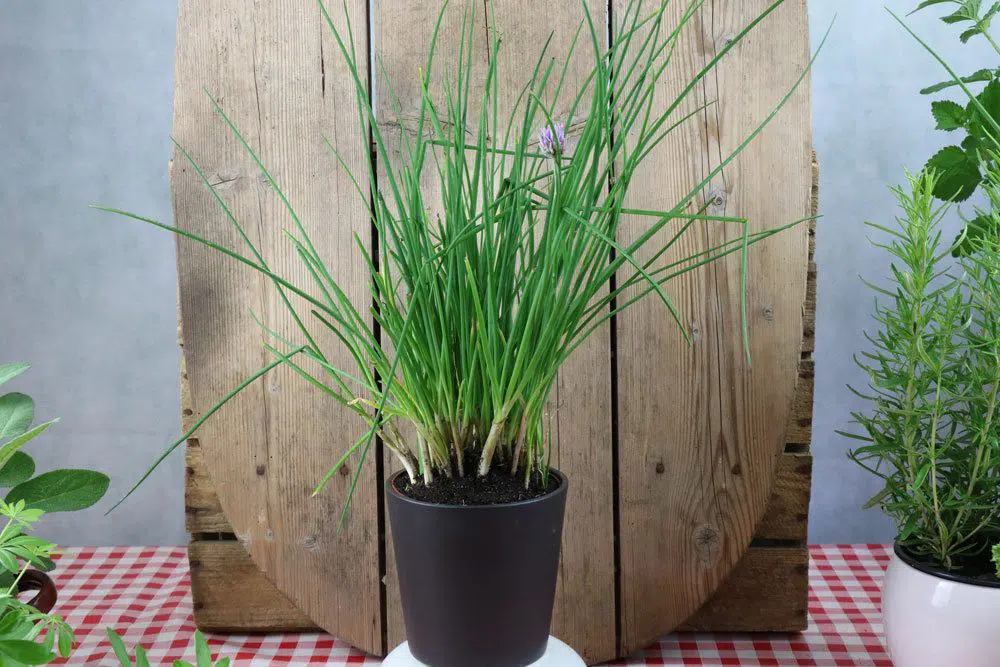Last updated on October 23rd, 2023 at 08:33 pm
Allium schoenoprasum, or simply chives, can be found in most home and amateur gardeners’ kitchen gardens. As a popular seasoning herb, it is easy to grow and has a high yield. But even if you don’t have a garden or even a balcony, you don’t have to do without this popular natural seasoning. We explain how to sow chives in pots and grow them on the proverbial windowsill in the kitchen.
Contents
Site requirements
Regardless of the decision to grow outdoors or in the home, it is first worth taking a look at the general site conditions under which the popular leek plant thrives optimally:
- Sunny to partial shade location.
- In full sunny locations with protection from too intense summer sun
- Comparatively high water requirement
- Soil with high water storage capacity, but at the same time very good drainage capacity due to high susceptibility to root rot caused by waterlogging
- High nutrient content in the soil, as a fast-growing plant with high requirements
- Ideal soil composition therefore proportionate humus and sandy components, to increase the water storage capacity with clay components
- Neutral to alkaline pH value in soil and water preferred, strong aversion to acidic environments
- High affinity to lime, therefore can be watered with tap water without problems
Chives in the apartment
The perfect care indoors
Since plants by nature usually thrive outdoors, the cultivation of chives inside an apartment is of course initially a difficulty that the amateur gardener must know how to deal with. However, this does not mean the end for the pot cultivation on the windowsill, much more, as a consequence of this, one should only attach even more importance to the selection and provision of the most ideal possible site conditions. Because while in the open often individual points do not turn out ideal, these weaknesses can easily be compensated by optimal conditions in other areas.
On the home windowsill, on the other hand, there is a completely “artificial” growing environment, so to speak, in which all general conditions must be specifically created and optimized.
However, with these tips and examples for the perfect location indoors, it is easy to overcome even this hurdle on the way to tasty spicy vegetables from homegrown:
Location
- bright location, e.g. windowsill facing south
- to protect from too intense sunlight, preferably with shading possibilities
Because of the usually constantly high temperatures and lack of (cooling) wind in living areas, it is better to shade the plants at an early stage than to risk dryness, overheating and burning due to too much solar radiation.
Soil
- mix the desired soil quality for the plant pot
- approx. 2/4 humus, 1/4 sand, 1/4 loamy components (e.g. garden soil/ topsoil)
Plant pot
- Choose a pot large enough to provide sufficient nutrient and water reservoirs.
- no specific pot shape required for root system, thus arbitrarily adaptable to location
- Provide drainage holes in the bottom of the pot to prevent waterlogging and cover the holes with potsherds or stones to prevent the soil from being washed out.
Ventilation
- too high drying out by wind in the interior mostly irrelevant
- instead, choose a location with ventilation options to prevent excessive waterlogging and permanent moisture on the stems
- for example near windows or balcony doors
Sowing
With regard to sowing and growing, chives are particularly easy-going and undemanding. Just as it is sown directly into the soil outdoors at the appropriate time, it can also be sown indoors directly into the intended plant pot. The seeds should be lightly pressed into the soil for lasting consistent moisture and thus good germination, or covered with a thin layer of soil. However, transplanting, pricking out or other care measures in the course of growth are not necessary. The most important prerequisite for good development of chives from sowing to harvesting is to ensure consistent environmental conditions and the provision of sufficient light, moisture, nutrients and ventilation.

Fertilizing
While the issues of light, air and moisture can be well controlled by a consciously chosen location, as well as regular care of the plant, the supply of nutrients, on the other hand, is easily pushed into the background. Whereas a dry soil in the plant pot is immediately obvious, a lack of nutrients usually only becomes apparent when the cut foliage is already damaged.
The fact that the nutrient reservoir in the plant pot is also significantly limited compared to outdoor sites means that the qualitative and quantitative nutrient supply of the plant should be taken into account through targeted soil improvement:
Before sowing: working humus soil or compost into the planting soil.
During cultivation: regular, moderate applications of organic vegetable fertilizer, e.g. by adding it to the irrigation water.
Lime: if lime-containing tap water is used as irrigation water, no additional watering is usually necessary; if the water is very low in lime, lime should be added before sowing and once or twice during growth, using garden lime or comparable preparations.


